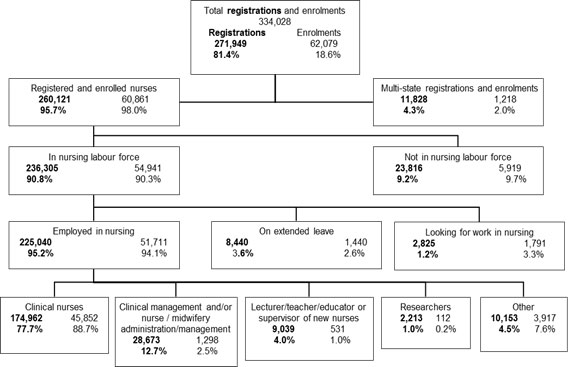Highlights
This bulletin presents summary findings on the nursing and midwifery labour force based on data from the 2009 Australian Institute of Health and Welfare Nursing and Midwifery Labour Force Survey. This survey collected information on the demographic and employment characteristics of nurses who were registered or enrolled in Australia at the time of the survey. The survey was done annually until 2009 by state and territory health authorities, with the questionnaire administered by the registration boards (or councils) in each jurisdiction, usually in conjunction with the registration renewal process.
The main findings of the report are as follows:
- In 2009, the total number of nurses identified by the Nursing and Midwifery Labour Force Survey (after adjusting for multiple registrations) was estimated to be 320,982, comprising 260,121 registered nurses and 60,861 enrolled nurses.
- The number of registered and enrolled nurses in the labour force (that is, employed in or looking for work in nursing in Australia) increased by 14.2% between 2005 and 2009, from 254,956 to 291,246.
- Between 2005 and 2009, the number of nurses actually employed in nursing increased by 13.3%, from 244,360 to 276,751.
- The average weekly hours worked by employed nurses and midwives increased slightly from 33.0 hours in 2005 to 33.3 hours in 2009. Over the same period, the proportion of nurses working part time (less than 35 hours per week) declined slightly from 49.8% to 47.7%.
- Overall, nursing supply increased by 6.2% between 2005 and 2009, from 1,040 full‑time equivalent (FTE) nurses per 100,000 population to 1,105 full‑time equivalent nurses, based on a 38-hour week. This was mainly a result of both a 13.3% increase in the number of employed nurses, and a 0.9% increase in the average hours they worked over this period.
- Nursing supply across regions ranged from 997 full‑time equivalent nurses per 100,000 population in Major cities to 1,240 in Very remote areas.
- Between 2005 and 2009, the proportion of employed nurses aged 50 years and over increased from 35.8% to 36.3%. The average age of nurses decreased from 45.1 years in 2005 to 44.3 years in 2009.
- Nursing continued to be a female dominated profession, with females comprising 90.4% of employed nurses in 2009 (down slightly from 92.1% in 2005).
Figure 1: Registered and enrolled nurses, by labour force status, 2009

Note: Numbers in bold print relate to registered nurses and plain to enrolled nurses. Nursing role is based on main nursing job.
Source: AIHW Nursing and Midwifery Labour Force Survey 2009.



